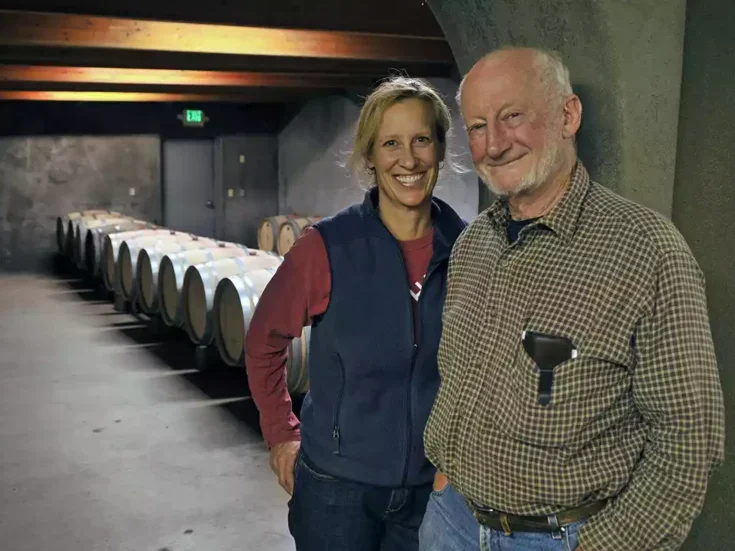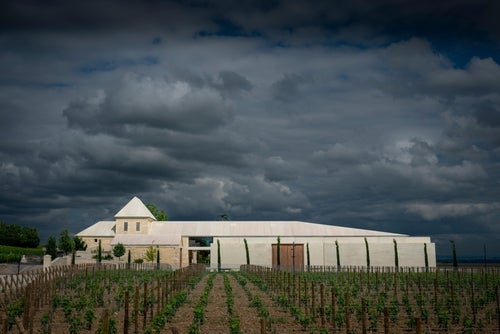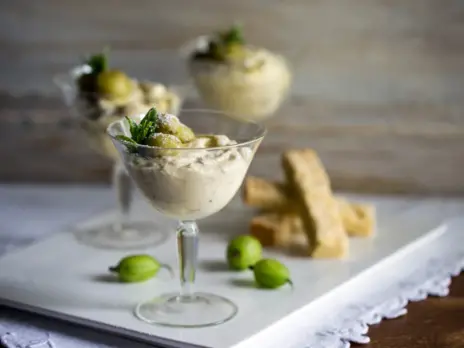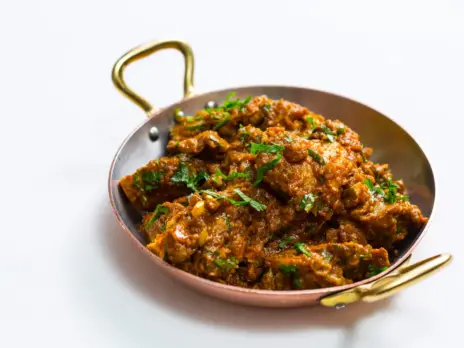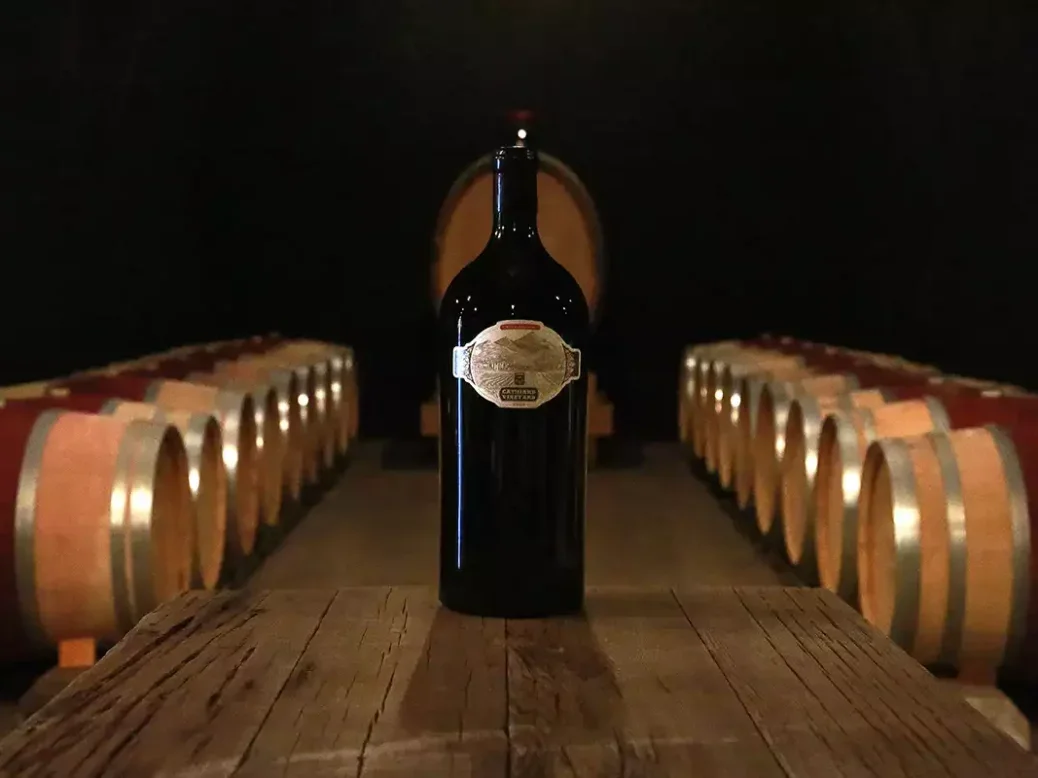
Anthony Rose reports from “The Judgment of Caudalie,” a London tasting initiated by Florence Cathiard, in which two wines from the Napa estate she owns with her husband, Daniel, were tasted alongside some of the the California region’s biggest names.
The “Judgment of Caudalie” in London was billed as a tasting of Napa Valley icons. The I-word is virtually devalued by overuse, but you could say here that icon is a kind of shorthand for cru classé in the absence of a Napa Valley classification. These were all good wines, expensive of course, and I don’t think there was any disagreement on either score. Whether or not you would place them all as first growths is a moot point, especially given that the likes of Harlan, Colgin, Bryant Family, Frank Family, Opus One, and Araujo Eisele were conspicuous by their absence. Where opinion was divided then was not so much on quality as on style.
The tasting was preceded by a brief introduction from Ella Lister of Wine Lister. It was Ella and her team’s idea to pit the Cathiard Napa Valley Sauvignon in a blind tasting against some of the best-known Napa Valley Cabernets from the 2021 vintage. Ella and the Wine Lister team were impressed when they tasted Cathiard Napa Vineyard for the first time. Ella said that she half-jokingly suggested to Florence Cathiard that they put it in a blind tasting. “Florence, being as brave, competent, and competitive as she is, agreed, and here we are,” said Ella.
Cathiard: Bringing Bordeaux balance
Florence Cathiard, the owner with her husband Daniel of Château Smith Haut Lafitte, gave a brief introduction to Cathiard Vineyard, noting that 2021 was their second vintage, made a year and a half after buying the St Helena property in January 2020. As soon as she and Daniel saw the old stone winery with its biodiversity, its soils of volcanic and sedimentary terroir (Rutherford dust), and vineyards including Cabernet blocks at altitude, she felt that it was the right fit. After that, she said, “It’s important to know where you stand among the greats. 2021 was a very good vintage in Napa.”
Cathiard Vineyard’s managing director Fabien Teitgen, with the Cathiards since 1995, was on hand to explain that after a year of ownership, they had started to get control of the vineyards and so were better able to work at the style they were looking for, given the differences in rootstocks and vine spacing between Napa and Bordeaux. 2021 was an early vintage and not very warm, with budbreak in mid-March, a drier year, with rainfall in winter. They decided on a short and not too large canopy. The harvest took place from September 6 to 29, and they ended up with small berries and very fresh wines.
According to Fabien, Napa and Bordeaux are very different. “In Napa you have to make Napa wine. We take some ideas from Bordeaux. The only thing I bring from Bordeaux is the idea of balance. In Napa, you easily get a large quantity of tannins and with the day / night temperature swings, the wines are very dark. You do need to pay careful attention to maintain the balance. You need to do that in the vineyard and in the cellar, avoiding excessive extraction.”
According to Florence, the best vineyards, with their mix of volcanic and petrified soils, are found on the west, where the ocean brings in cold air and where there is more shade and vegetation. Cathiard Vineyard comprises almost 300 acres (120ha), with 62 acres (25ha) of red wine grapes, mainly Cabernet Sauvignon, and a quarter of the estate is dry-farmed. The oldest vines are 46 years old and the yield is low, at 1.5 tonnes per acre. The cellar is a 330ft (100m) horseshoe carved into the rock in the Mayacamas Mountains.
We journalists had no idea what the wines were, apart from Cathiard Vineyard, but we had been told at least that Screaming Eagle and Scarecrow would be among them. I don’t think any of us were that familiar with the wines, which is perhaps not surprising. British wine journalists like myself were “brought up” on Bordeaux, and our view of Cabernet Sauvignon, rarely at 100%, is largely through the Anglocentric prism of Bordeaux. But the opportunity to taste ten Napa Valley Cabernet Sauvignons side by side does not come along every day, so we were all very grateful for it.
The ground rules were that we had to taste the ten wines and rank them in order, from 1 for the best, to 10 for the least liked, and our scores would be used to rank the wines in order from first to last. We didn’t have to give tasting notes or scores or even our names, thereby potentially saving blushes beforehand. I did sign my rating sheet, if only to avoid any subsequent suggestion of tinkering, when writing up our tasting notes and scores. Not that I’m suggesting, heaven forfend, that any of my fellow scribes who submitted their sheets anonymously indulged in such skulduggery.
Before the order of preference was announced, the discussion revealed considerable diversity of opinion on the preferred wines. There was at least some agreement on the styles, which divided roughly into expectations, on the one hand, of a traditional or classic Napa with plenty of oak, tannin, and alcohol, and a more modern, even elegant, take on the Napa style. The traditional styles certainly showed more in the way of overt smoky oak in the aromas and flavors, with chunky, hefty, tannins and marginally higher alcohol. The more modern styles were lighter on their feet, with more integrated oak, brighter fruit, and less extracted, more supple, tannins.
After the big reveal, there was no patting-oneself-on-the back-I-got-it right sort of stuff. I think it’s fair to say that no-one “got it right,” but then again, no-one got it wrong. These were all good wines, but wines that varied not so much in quality as in style, and each of us had our own preferences. Two of my favorite wines came relatively low down, while one or two that I found too oaky or too tannic, performed pretty well overall.
Perhaps the biggest surprise for me was how well the two Cathiard wines showed (Florence had cheekily inserted not just her Cabernet Sauvignon but her old-vine blend, Founding Brothers, too). These to me were more in the modern, bright, elegantly balanced style and relatively approachable, especially the Founding Brothers. Of the top five, I was not a huge fan of Screaming Eagle, to me a typical, traditional Napa Valley Cabernet style; richly concentrated, yes, but a little too heftily extracted for my liking, Scarecrow even more so. I’m prepared to accept, given that all these wines were still painted in primary colors, that time may yet work its magic.
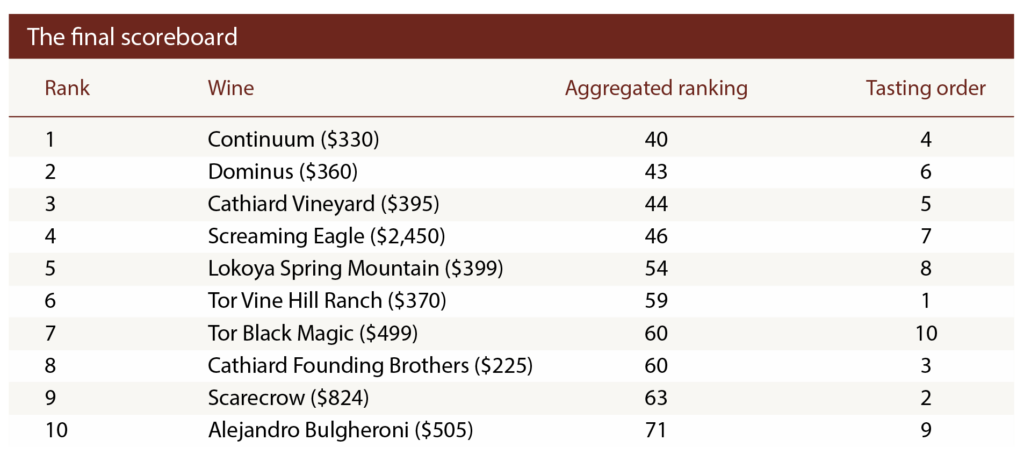
Tasting—Anthony Rose’s notes and scores
2021 Tor Vine Hill Ranch Cabernet Sauvignon
Deep, dense, youthful ruby, super mulberry and berry fragrance, with a subtle background of smoky oak, but fresh and well-integrated; sumptuous fruit richness assails the palate, showing red-fruit flavors underpinned by a juicy-textured acidity and silky, fine-grained tannins; still at a primary stage of its youthful life, and savory, it almost asks to be drunk now, but the structure is there for longer aging. | 97
2021 Scarecrow Cabernet Sauvignon
Deep, dense ruby, the first whiff is of distinctly smoky oaky aromas that sit over the wine and slightly mask the fruit; when you taste, that smoky oak is still there but integrates better into the wine, which is full of super-ripe, red fruit flavors, while the fruit is underpinned by substantial, grippy tannins, almost to the point of slight astringency, even a dry bitterness; yes, that helps to maintain freshness and potential longevity but for me it’s closer to what I think of as the traditionally big, oak-laden Napa Valley Cabernet. | 94
2021 Cathiard Founding Brothers
Spicy aromatics, deep and dense in primary ruby colors. The aromas here are complex, spicy, fruity, and perfumed, with a hint of spicy oak but well-integrated and under control; the fruit here is close to black cherry, concentrated and rich, almost Bordeaux-like perhaps, with a touch more opulence on the mid-palate, good structure of acid backbone and fine-grained tannins, super-elegant, with a hint of astringency, but combining well together for excellent aging potential. Super-stylish. | 97
2021 Continuum
The deepest and densest, most youthful ruby of the wines so far tasted, this shows ruby all the way to the rim of the glass; there’s a lovely freshness and fragrance of super-ripe, dark red fruits, cherries, raspberries, and more than a hint of smoky of background oak; a feeling it could be a Bordeaux cru classé in a ripe vintage; on tasting, this is extremely rich and voluptuous, fleshy in the mouth, decadent even, or would be if it weren’t for a streak of acid freshness and the firmish grip of tannins kicking in after the initial whack of texture and flavor. Big wine, in the end more Napa than Bordeaux, with good aging potential. | 95+
2021 Cathiard Vineyard Cabernet Sauvignon
A deep, dense youthful ruby, this has a delightful fragrance derived from a combination of red fruits on the one hand, and a gently smoky, overt, almond and vanilla-like oak spiciness on the other; there is also a note of evolution to it, more than on the others; it’s rich, sumptuous, and concentrated to taste, with a beguiling red fruit quality mingling with the oak, which remains quite smoky on the mid-palate, gently easing on the finish with a structure of well-balanced acidity and extracted, grippy tannins for 10+ years aging potential. | 95+
2021 Dominus
A deep primary ruby in color, the aromas here are of fresh red fruit, quite charming in fact, with subtle oak character, unlike some of the other wines; it feels honest and well-integrated; and the same is true on the palate, with fine, ripe, and rich red-berry fruit concentration, completely integrated oak, a peppery background; the acidity and the tannins kick in soon after the flavors have started to unfold; but elegant and classic, still needing time to soften down. | 94-95
2021 Screaming Eagle Cabernet Sauvignon
A bright, youthful ruby and primary in color, this is quite different from many in its aromatic profile, showing the likes of mulberry and darkish berry fruit all the while underpinned by a light, smoky oak element; there’s sumptuously rich concentrated fruit in the glass here with plenty of red and black cherry, all underpinned by a lively bright streak of almost minerally acidity and a firm almost iron grip of extracted dry tannin; big structure with plenty of potential for aging. | 94+
2021 Lokoya Cabernet Sauvignon Spring Mountain
A very dense, youthful ruby, with red all the way to the rim of the glass, this is surprisingly shy in aroma, yet fresh, subdued, and too youthful to articulate what lies in store, a bud waiting to unfurl; the fruit is dark, rich, and concentrated, underpinned by good fresh acidity and firm, with solid, dry tannins toward the end as the dark fruit subsides on the tongue; at this stage it’s dry and firmly extracted, at an elemental stage, awaiting instructions to express itself. | 93
2021 Alejandro Bulgheroni Estate Cabernet Sauvignon
Youthful and primary in ruby color, this has some delightful, ripe, dark red-fruit characters, framed by liquor spice, and the flavors that follow are rich and concentrated, with dark, red-berry and mulberry fruit; the texture is sinewy and well-wrought, and even though it’s a big wine, there’s a nicely integrated freshness of acidity and tannins; although chewy at the start. The tannins are starting to soften in the glass, bringing an excellent overall balance, not to mention aging potential. | 96
2021 Tor Cabernet Sauvignon Black Magic
A good dense ruby, this is fresh and spicy in aroma, open on the nose, distinctly and invitingly so, with plenty of bright, red-fruit flavous and a nice spiciness, but although it comes on an attractive red fruit, and the underlying backbone of acidity is fresh, it’s quite heftily extracted, leaving you with an impression of slight astringency and dryness on the finish, asking the question, how long will this take to resolve? | 93+


